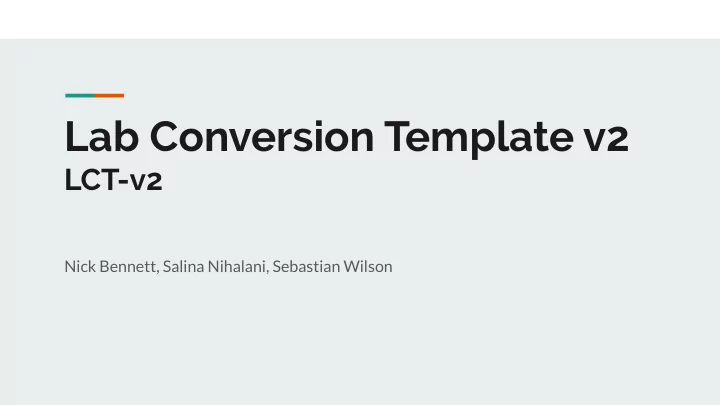

Lab Conversion Template v2 LCT-v2 Nick Bennett, Salina Nihalani, Sebastian Wilson
Introduction
The LCT v2 Team Nick Bennett 4th year Computer Science Major ● Skills: Java, Python, SQL, React/Javascript, C ● Salina Nihalani 2nd year Computer Science Major ● Skills: Java, React/Javascript, Python ● Sebastian Wilson 1st year Computer Science Major ● Skills: Java, JavaScript/React ●
What is LCT? Standard process for converting older MATLAB GUIs to JavaScript ● Using React ● Repository of functional code snippets ● Allows for hierarchical structure and capturing of state information ●
Why did we create LCT? Students have run into common problems every semester when ● creating Lab GUIs Having a standard process can avoid running into these problems ● repeatedly Allows students to focus on more complex graphing logic ● Overall will increase productivity for new students ●
What’s new in LCT v2 Restructured to take better advantage of React state handling ● Designed to include lab worksheets and GUIs together ● Improved state handling and saving/restoring of worksheet state ● Database connectivity ●
Project Design
Project Details Two demo apps: one frontend and one frontend + backend ● Created using create-react-app, jsxgraph-react-js, and express ● Uses React data model to share state information between GUI and ● Worksheet portions of the Lab Express backend for database connectivity ●
Why React? Built-in handling of data flow through states ● Modularity and reusability via Components ● Allows for scalability along with simplicity ○ Formal organization and structure ● Thriving ecosystem for packages and tools ●
Demo 1 (JSON Database) Restructured to include Worksheet and GUI sections ● Worksheet is able to read GUI state ● GUI is improved version of the LCT Test page from previous semester ● Contains implementations of every basic feature needed to create a ● GUI Code files are heavily annotated and organized to be easily ● copied/pasted into other projects Code structure more modular allowing for easy insertion of ● components
Worksheet Creation Template (Demo 1) Generates worksheet from static json file (WorksheetData.json) ● Predefined json file structure ● Defined by hierarchy of segments (Parts, questions, question parts, ● inputs) Standardized worksheet format ● Can interact with GUI state ● Modularity: Worksheet can have arbitrary segmentation with minimal ● hard coding
Worksheet Creation Template: Implementation (Demo 1) Constructor: Paste WorksheetData.json file contents and convert to new json file ● called “DynamicAnswers.json” which stores inputted data. In the state, either paste WorksheetData.json contents again or read from “DynamicAnswers.json.” createWorksheet(): Function that reads from WorksheetData, the static json file ● containing the worksheet questions, to generate arbitrary numbers of parts, questions, question parts, and input boxes, each with their own associated text. handleInputChange(): Updates “DynamicAnswers.json” ●
Worksheet Creation Template: JSON Structure
Demo Two (MySQL database) Utilizes MySQL database to store worksheet components ● in a table Secures a connection to database using TypeScript ● Frontend utilizes React to display basic worksheet ●
Next Steps Fully integrate database and backend ● Finish implementation of real labs ● Finish worksheet generation to be more robust ● Integrate more reusability via React Components ● Gather feedback ●
Recommend
More recommend